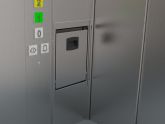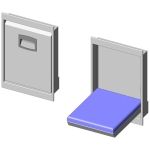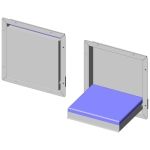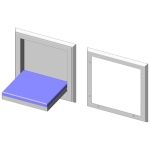
Fold down seats in elevator / lift cars
In case of new construction, modification or retrofitting:
The durable fold down seats of KLAPPSITZ.de are perfectly suited as a sitting possibility in elevators.
They can be mounted onto or flush in built into the inner wall of the elevator and if desired can even be fitted with a cover plate that is in style of the elevator’s interior design. All in all, our seats are as variable as the possibilities of application – there are no limits to the variations and for many intended purposes we have already thought ahead to make them possible for our customers.
Affordable solution for modifications or retrofittings:
The retrofitting of fold down seats in
elevators is usually very tricky. Often the elevators have no
sufficiently stable underlying construction. But the good news is
that we have developed mounting solutions and components for our
folding seats which do not require to strengthen the walls in a
cumbersome procedure.
Is there a defective or uncomfortable seat in the elevator cabin? We can offer replacement parts which are compatible to several other competitors and which can thus easily be switched.
If unobstructed access is required:
Especially with elevator seats the needs of
persons with disabilities have to be considered given that they are primarily a
means of transportation for them. That means if the elevator has to follow the
guidelines for unobstructed access, meaning the requirement DIN EN-81-70 is to
be followed, certain adjustments have to be made or kept in mind in the construction
of elevator seats. Whether the desired seat is in accordance with these
guidelines can be looked up in the product detail page.
As always, we are more than happy to offer comprehensive advice where the requirements concerning this guideline, please do not hesitate to contact us.







Specifications and dimension sheets for download
Please feel free to contact us. We would like to support you in the analysis and planning and finding your suitable product for a new elevator or for modifying of an older elevator.
Seats „Kompakt“ for new construction project
Fold down seat without back rest, narrow
model: 007-10 to the details page
to the details pageThe seat is brought into the resting position by the means of springs that will automatically bring the seat back into resting position against the wall when not in use.
This seat is 50 mm (about 2 inches) slimmer than the model 007-05 and is thus even better suited for areas with limited available space.
Fold down seat without back rest, with bump stop for resting position
model: 007-39 to the details page
to the details pageThe seating area is brought into the resting position by the means of springs. In this model the seat will not fold back against the wall on its own but is locked in position by an integrated bump stop which keeps it in the vertical position. Because of this, the seat is also suitable for hard seating area materials such as wood or metal.
Please consider that your wall must be able to support the weight of the seat construction and a person when the seat is being used.
If the durability of the desired area is unclear it is better to decide for a seat with higher wall fittings or with a back rest as these models are more safely anchored and thus make the transfer of force and weight to the overall construction easier.Fold down seat without back rest, narrow, with bump stop for resting position
model: 090-33 to the details page
to the details pageThe seating area is brought into the resting position by the means of springs. In this model the seat will not fold back against the wall on its own but is locked in position by an integrated bump stop which keeps it in the vertical position. Because of this, the seat is also suitable for hard seating area materials such as wood or metal.
This seat is 50 mm (about 2 inches) slimmer than the model 007-39 and is thus even better suited for areas with limited available space.
Fold down seat without back rest, mini
model: 007-37 to the details page
to the details pageThe seat is brought into the resting position by the means of springs that will automatically bring the seat back into resting position against the wall when not in use.
This seat is 100 mm (about 4 inches) shorter than the model 007-10 and is thus suited for areas with extremely limited available space.
Fold down seat without back rest, mini, with bump stop for resting position
model: 007-66 to the details page
to the details pageThe seating area is brought into the resting position by the means of springs. In this model the seat will not fold back against the wall on its own but is locked in position by an integrated bump stop which keeps it in the vertical position. Because of this, the seat is also suitable for hard seating area materials such as wood or metal.
This seat is 50 mm (about 2 inches) narrower and 100 mm (about 4 inches) shorter than model 090-33 and thus available when available space is extremely limited.
Fold down seat without back rest, extra narrow
model: 007-14 to the details page
to the details pageThe seat is brought into the resting position by the means of springs that will automatically bring the seat back into resting position against the wall when not in use.
This seat is another 50 mm (about 2 inches) slimmer than the model 007-10 even, so a total of 100 mm (about 4 inches) slimmer than model 007-05 and is thus especially suited for areas with limited available space.
Flush built-in fold down seat
model: 007-13 (mild steel) to the details page
to the details pageFold down seat that’s flush-mounted into the wall. The seating area is brought into a resting position by the means of springs that will automatically bring the seat back into resting position against the wall when not in use (but only with the padded seat options). Hard surfaced seating areas must not fold up on their own accord as there could be a risk of injury.
Intended for the use in elevator cabin but can be installed in other areas as well. The installation depth measures a mere 82 mm (3.2 inches). The screws used for the installation of the seat remain visible but if the wall is accessible from behind non-visible bolts can be installed as the installation is then executed from behind with screw nuts.
This seat matches the parameters of BS EN 81-70 (Accessibility to lifts for persons including persons with disability) if the seat is installed for the seating area to have a height of 48 to 52 cm (18.9 to 20,4 inches). The EN 81-70 is a part of the regulation DIN 18040 (barrier-free building – basis for planning), part one and two.
Flush built-in fold down seat with black wall case
model: 007-24 (stainless steel) to the details page
to the details pageThe only difference between this folding seat and the standard 007-24 model is that it has a steel wall case in matte black instead of stainless steel.
The appearance when folded up is exactly the same as a folding seat made entirely of stainless steel. If you fold down the seat, you can see the black interior. Visually, this circumstance does not disturb at all, because the black upholstery and the black wall housing complement each other perfectly. Technically, there are also no differences or even disadvantages.
The big advantage lies in the manufacturing costs. With the black wall housing, this folding seat is around 17 percent cheaper.
Flush built-in fold down seat
model: 007-24 (stainless steel) to the details page
to the details pageFold down seat that’s flush-mounted into the wall. The seating area is brought into a resting position by the means of springs that will automatically bring the seat back into resting position against the wall when not in use (but only with the padded seat options). Hard surfaced seating areas must not fold up on their own accord as there could be a risk of injury.
Intended for the use in elevator cabin but can be installed in other areas as well. The installation depth measures a mere 82 mm (3.2 inches). The screws used for the installation of the seat remain invisible behind the masking frame.
This seat matches the parameters of BS EN 81-70 (Accessibility to lifts for persons including persons with disability) if the seat is installed for the seating area to have a height of 48 to 52 cm (18.9 to 20,4 inches). The EN 81-70 is a part of the regulation DIN 18040 (barrier-free building – basis for planning), part one and two.
Flush built-in fold down seat, narrow
model: 007-52 (mild steel) to the details page
to the details pageFold down seat that’s flush-mounted into the wall. The seating area is brought into a resting position by the means of springs that will automatically bring the seat back into resting position against the wall when not in use (but only with the padded seat options). Hard surfaced seating areas must not fold up on their own accord as there could be a risk of injury.
Intended for the use in elevator cabin but can be installed in other areas as well. The installation depth measures a mere 82 mm (3.2 inches). The screws used for the installation of the seat remain visible but if the wall is accessible from behind non-visible bolts can be installed as the installation is then executed from behind with screw nuts.
This seat is smaller than 007-13 and is thus suited in case of a lack of space but because of its more narrow build does not fulfil the requirements of the BS EN 81-70.
Flush built-in fold down seat, narrow
model: 007-53 (stainless steel) to the details page
to the details pageFold down seat that’s flush-mounted into the wall. The seating area is brought into a resting position by the means of springs that will automatically bring the seat back into resting position against the wall when not in use (but only with the padded seat options). Hard surfaced seating areas must not fold up on their own accord as there could be a risk of injury.
Intended for the use in elevator cabin but can be installed in other areas as well. The installation depth measures a mere 82 mm (3.2 inches). The screws used for the installation of the seat remain invisible behind the masking frame.This seat is smaller than 007-24 and is thus suited in case of a lack of space but because of its more narrow build does not fulfil the requirements of the BS EN 81-70.
Flush built-in fold down seat, mini
model: 123-01 (stainless steel) to the details page
to the details pageFold down seat that’s flush-mounted into the wall. The seating area is brought into a resting position by the means of springs that will automatically bring the seat back into resting position against the wall when not in use (but only with the padded seat options). Hard surfaced seating areas must not fold up on their own accord as there could be a risk of injury.
Intended for the use in elevator cabin but can be installed in other areas as well. The installation depth measures a mere 82 mm (3.2 inches). The screws used for the installation of the seat remain invisible behind the masking frame.
This seat is very narrow with a seating area that measures only 349 mm (about 13.7 inches) and is thus ideally suited for very limited spaces but because of its narrow build does not fulfil the requirements of the BS EN 81-70.
Flush built-in fold down seat, with covered in-wall installation
model: 007-69 (mild steel) to the details page
to the details pageFold down seat that’s built into the wall. The seating area is brought into a resting position by the means of springs that will automatically bring the seat back into resting position against the wall when not in use (but only with the padded seat options). Hard surfaced seating areas must not fold up on their own accord as there could be a risk of injury.
The seat is mounted to a supporting structure, the wall frame of the seat is later cased. The seating area protrudes 19 mm (0.7 inches) from the wall to align the seating area and the casing. Other protrusions are possible.
The edges of the sheathing area surrounding the seat should be fittingly durable (especially if it is drywall).
Seats „Kompakt“ for retrofitting and retooling
Accessory: Wall-casing for flush built-in fold down seat
model: 104-05 to the details page
to the details pageThis casing is best suited for the modification of fold down seats in elevator cabins.
The following models can be fitted with this application: 007-13 or 007-24.
With this casing it is not required to cut an opening and the forces are mostly channelled into the floor. Because of this an additional reinforcing of the wall-backside can be mostly or even entirely omitted.
The casing has a depth of only 85 mm (3.3 inches).
Accessory: Wall-casing for flush built-in fold down seat, narrow
model: 104-06 to the details page
to the details pageThis casing is best suited for the modification of fold down seats in elevator cabins.
The following models can be fitted with this application: 007-52 or 007-53.
With this casing it is not required to cut an opening and the forces are mostly channelled into the floor. Because of this an additional reinforcing of the wall-backside can be mostly or even entirely omitted.
The casing has a depth of only 85 mm (3.3 inches).
Accessory: Wall-casing for flush built-in fold down seat
model: 104-11 to the details page
to the details pageWith this casing formation-assembly of the seat models 007-13 and 007-24 is made possible. As such the casing is suitable to modify seats in elevator cabins should the cutting of the cabin wall is not desired.
The casing made of stainless steel has a depth of only 82 mm (3.2 inches), the casing made of mild steel has a depth of 87 mm (3.4 inches).
Accessory: Wall-casing for flush built-in fold down seat, narrow
model: 104-13 to the details page
to the details pageWith this casing formation-assembly of the seat models 007-52 and 007-53 is made possible. As such the casing is suitable to modify seats in elevator cabins should the cutting of the cabin wall is not desired.
The casing made of stainless steel has a depth of only 82 mm (3.2 inches), the casing made of mild steel has a depth of 87 mm (3.4 inches).
Accessory: Spacer frame for flush built-in fold down seat
model: 104-08 to the details page
to the details pageThis spacer frame reduces the installation depth of a fold down seat for about 30 mm (1.2 inches).
Applicable to the models 007-13 and 007-24.
Accessory: Spacer frame for flush built-in fold down seat, narrow
model: 104-09 to the details page
to the details pageThis spacer frame reduces the installation depth of a fold down seat for about 30 mm (1.2 inches).
Applicable to the models 007-52 and 007-53.
Accessory: Spacer frame for flush built-in fold down seat
model: 104-10 to the details page
to the details pageThis spacer frame reduces the installation depth of a fold down seat for about 45 mm (1.8 inches).
Applicable to the models 007-13 and 007-24.
Accessory: Spacer frame for flush built-in fold down seat, narrow
model: 104-14 to the details page
to the details pageThis spacer frame reduces the installation depth of a fold down seat for about 45 mm (1.8 inches).
Applicable to the models 007-52 and 007-53.
Elevator Seat
model: 090-35 to the details page
to the details pageThis seat is made to replace damaged or broken seats of our competitors but can of course be used in different areas. The seat is brought into a resting position by the means of springs that will automatically bring the seat back into resting position against the wall when not in use.
If the existing hole-pattern in your elevator cabin fits the measurements 330 x 220 mm (breadth x height) (13 x 8.66 inches) this seat can be installed without any further adjustments.
Elevator Seat
model: 121-13 to the details page
to the details pageThis seat is made to replace damaged or broken seats of our competitors but can of course be used in different areas. The seat is brought into a resting position by the means of springs that will automatically bring the seat back into resting position against the wall when not in use.
If the existing hole-pattern in your elevator cabin fits the measurements 410 x 220 mm (breadth x height) (16.14 x 8.66 inches) this seat can be installed without any further adjustments.
Elevator seat
model: 123-12 (stainless steel) to the details page
to the details pageThis seat is made to replace damaged or broken seats of our competitors. Our competitor fused the wall recess into the wall of the elevator cabin and the folding seat was screwed into this recess. Our seat has no wall casing of its own but the wall recess does not have to be removed.
If the measurements of the wall recess in your elevator cabin fit the dimensions 384 x 340 x 63 mm (h x b x d) (15.1 x 13.4 x 2.4 inches) this seat can simply be swapped for the preinstalled, damaged seat.
Because of the pre-existing measurements the seating area is comparably small.
BLECH & TECH GmbH
Niederwaldstraße 4
79336 Herbolzheim, Germany
+49 (0) 76 43 / 33 38 95 - 0
+49 (0)76 43 / 33 38 95 - 11
nfblch-tchd
©2025 BLECH & TECH GmbH


